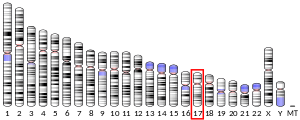SEPT9
Septin-9 is a protein that in humans is encoded by the SEPT9 gene.[5][6][7]
Function
Along with AHNAK, eIF4E and S100A11, SEPT9 has been shown to be essential for pseudopod protrusion, tumor cell migration and invasion.[9]
Clinical significance
The v2 region of the SEPT9 promoter has been shown to be methylated in colorectal cancer tissue compared with normal colonic mucosa.[10] Using highly sensitive real time PCR assays, methylated SEPT9 was detected in the blood of colorectal cancer patients. This alternate methylation pattern in cancer samples is suggestive of an aberrant activation or repression of the gene compared to normal tissue samples.[11][12]
Testing to detect methylated SEPT9 is not indicated as a first option for colorectal cancer screening.[13] It is similar in specificity and sensitivity to the stool guaiac test or fecal immune tests, and those tests should be used in preference.[13] In cases when the physician aggressively has recommended a colonoscopy and the patient has declined that and these other tests, then this test has advantages over patients having no screening at all.[13]
See also
References
- ENSG00000184640 GRCh38: Ensembl release 89: ENSG00000282302, ENSG00000184640 - Ensembl, May 2017
- GRCm38: Ensembl release 89: ENSMUSG00000059248 - Ensembl, May 2017
- "Human PubMed Reference:". National Center for Biotechnology Information, U.S. National Library of Medicine.
- "Mouse PubMed Reference:". National Center for Biotechnology Information, U.S. National Library of Medicine.
- Osaka M, Rowley JD, Zeleznik-Le NJ (May 1999). "MSF (MLL septin-like fusion), a fusion partner gene of MLL, in a therapy-related acute myeloid leukemia with a t(11;17)(q23;q25)". Proceedings of the National Academy of Sciences of the United States of America. 96 (11): 6428–33. doi:10.1073/pnas.96.11.6428. PMC 26898. PMID 10339604.
- Taki T, Ohnishi H, Shinohara K, Sako M, Bessho F, Yanagisawa M, Hayashi Y (Sep 1999). "AF17q25, a putative septin family gene, fuses the MLL gene in acute myeloid leukemia with t(11;17)(q23;q25)". Cancer Research. 59 (17): 4261–5. PMID 10485469.
- "Entrez Gene: SEPT9 septin 9".
- Surka MC, Tsang CW, Trimble WS (Oct 2002). "The mammalian septin MSF localizes with microtubules and is required for completion of cytokinesis". Molecular Biology of the Cell. 13 (10): 3532–45. doi:10.1091/mbc.E02-01-0042. PMC 129964. PMID 12388755.
- Shankar J, Messenberg A, Chan J, Underhill TM, Foster LJ, Nabi IR (May 2010). "Pseudopodial actin dynamics control epithelial-mesenchymal transition in metastatic cancer cells". Cancer Research. 70 (9): 3780–90. doi:10.1158/0008-5472.CAN-09-4439. PMID 20388789.
- http://www.transatlantic-symposium.de/content/_docs/doc1241003872263.pdf
- Grützmann R, Molnar B, Pilarsky C, Habermann JK, Schlag PM, Saeger HD, Miehlke S, Stolz T, Model F, Roblick UJ, Bruch HP, Koch R, Liebenberg V, Devos T, Song X, Day RH, Sledziewski AZ, Lofton-Day C (2008). "Sensitive detection of colorectal cancer in peripheral blood by septin 9 DNA methylation assay". PLoS ONE. 3 (11): e3759. doi:10.1371/journal.pone.0003759. PMC 2582436. PMID 19018278.
- deVos T, Tetzner R, Model F, Weiss G, Schuster M, Distler J, Steiger KV, Grützmann R, Pilarsky C, Habermann JK, Fleshner PR, Oubre BM, Day R, Sledziewski AZ, Lofton-Day C (Jul 2009). "Circulating methylated SEPT9 DNA in plasma is a biomarker for colorectal cancer". Clinical Chemistry. 55 (7): 1337–46. doi:10.1373/clinchem.2008.115808. PMID 19406918.
- American Society for Clinical Pathology, "Five Things Physicians and Patients Should Question", Choosing Wisely: an initiative of the ABIM Foundation, American Society for Clinical Pathology, retrieved August 1, 2013, which cites
- Thompson AJ, Muir AJ, Sulkowski MS, Ge D, Fellay J, Shianna KV, Urban T, Afdhal NH, Jacobson IM, Esteban R, Poordad F, Lawitz EJ, McCone J, Shiffman ML, Galler GW, Lee WM, Reindollar R, King JW, Kwo PY, Ghalib RH, Freilich B, Nyberg LM, Zeuzem S, Poynard T, Vock DM, Pieper KS, Patel K, Tillmann HL, Noviello S, Koury K, Pedicone LD, Brass CA, Albrecht JK, Goldstein DB, McHutchison JG (Jul 2010). "Interleukin-28B polymorphism improves viral kinetics and is the strongest pretreatment predictor of sustained virologic response in genotype 1 hepatitis C virus". Gastroenterology. 139 (1): 120–9.e18. doi:10.1053/j.gastro.2010.04.013. PMID 20399780.
- Ahlquist DA, Taylor WR, Mahoney DW, Zou H, Domanico M, Thibodeau SN, Boardman LA, Berger BM, Lidgard GP (Mar 2012). "The stool DNA test is more accurate than the plasma septin 9 test in detecting colorectal neoplasia". Clinical Gastroenterology and Hepatology. 10 (3): 272–7.e1. doi:10.1016/j.cgh.2011.10.008. PMC 3980432. PMID 22019796.
Further reading
- Pellegrino JE, George RA, Biegel J, Farlow MR, Gardner K, Caress J, Brown MJ, Rebbeck TR, Bird TD, Chance PF (Dec 1997). "Hereditary neuralgic amyotrophy: evidence for genetic homogeneity and mapping to chromosome 17q25". Human Genetics. 101 (3): 277–83. doi:10.1007/s004390050629. PMID 9439655.
- Nagase T, Ishikawa K, Suyama M, Kikuno R, Hirosawa M, Miyajima N, Tanaka A, Kotani H, Nomura N, Ohara O (Feb 1999). "Prediction of the coding sequences of unidentified human genes. XIII. The complete sequences of 100 new cDNA clones from brain which code for large proteins in vitro". DNA Research. 6 (1): 63–70. doi:10.1093/dnares/6.1.63. PMID 10231032.
- Medina M, Marinescu RC, Overhauser J, Kosik KS (Jan 2000). "Hemizygosity of delta-catenin (CTNND2) is associated with severe mental retardation in cri-du-chat syndrome". Genomics. 63 (2): 157–64. doi:10.1006/geno.1999.6090. PMID 10673328.
- Kalikin LM, Sims HL, Petty EM (Jan 2000). "Genomic and expression analyses of alternatively spliced transcripts of the MLL septin-like fusion gene (MSF) that map to a 17q25 region of loss in breast and ovarian tumors". Genomics. 63 (2): 165–72. doi:10.1006/geno.1999.6077. PMID 10673329.
- Russell SE, McIlhatton MA, Burrows JF, Donaghy PG, Chanduloy S, Petty EM, Kalikin LM, Church SW, McIlroy S, Harkin DP, Keilty GW, Cranston AN, Weissenbach J, Hickey I, Johnston PG (Sep 2000). "Isolation and mapping of a human septin gene to a region on chromosome 17q, commonly deleted in sporadic epithelial ovarian tumors". Cancer Research. 60 (17): 4729–34. PMID 10987277.
- McIlhatton MA, Burrows JF, Donaghy PG, Chanduloy S, Johnston PG, Russell SE (Sep 2001). "Genomic organization, complex splicing pattern and expression of a human septin gene on chromosome 17q25.3". Oncogene. 20 (41): 5930–9. doi:10.1038/sj.onc.1204752. PMID 11593400.
- Yamamoto K, Shibata F, Yamaguchi M, Miura O (Jun 2002). "Fusion of MLL and MSF in adult de novo acute myelomonocytic leukemia (M4) with t(11;17)(q23;q25)". International Journal of Hematology. 75 (5): 503–7. doi:10.1007/BF02982114. PMID 12095151.
- Surka MC, Tsang CW, Trimble WS (Oct 2002). "The mammalian septin MSF localizes with microtubules and is required for completion of cytokinesis". Molecular Biology of the Cell. 13 (10): 3532–45. doi:10.1091/mbc.E02-01-0042. PMC 129964. PMID 12388755.
- Nagata K, Kawajiri A, Matsui S, Takagishi M, Shiromizu T, Saitoh N, Izawa I, Kiyono T, Itoh TJ, Hotani H, Inagaki M (May 2003). "Filament formation of MSF-A, a mammalian septin, in human mammary epithelial cells depends on interactions with microtubules". The Journal of Biological Chemistry. 278 (20): 18538–43. doi:10.1074/jbc.M205246200. PMID 12626509.
- Beausoleil SA, Jedrychowski M, Schwartz D, Elias JE, Villén J, Li J, Cohn MA, Cantley LC, Gygi SP (Aug 2004). "Large-scale characterization of HeLa cell nuclear phosphoproteins". Proceedings of the National Academy of Sciences of the United States of America. 101 (33): 12130–5. doi:10.1073/pnas.0404720101. PMC 514446. PMID 15302935.
- Nagata K, Asano T, Nozawa Y, Inagaki M (Dec 2004). "Biochemical and cell biological analyses of a mammalian septin complex, Sept7/9b/11". The Journal of Biological Chemistry. 279 (53): 55895–904. doi:10.1074/jbc.M406153200. PMID 15485874.
- Scott M, Hyland PL, McGregor G, Hillan KJ, Russell SE, Hall PA (Jul 2005). "Multimodality expression profiling shows SEPT9 to be overexpressed in a wide range of human tumours". Oncogene. 24 (29): 4688–700. doi:10.1038/sj.onc.1208574. PMID 15782116.
- Ito H, Iwamoto I, Morishita R, Nozawa Y, Narumiya S, Asano T, Nagata K (Oct 2005). "Possible role of Rho/Rhotekin signaling in mammalian septin organization". Oncogene. 24 (47): 7064–72. doi:10.1038/sj.onc.1208862. PMID 16007136.
- Scott M, McCluggage WG, Hillan KJ, Hall PA, Russell SE (Mar 2006). "Altered patterns of transcription of the septin gene, SEPT9, in ovarian tumorigenesis". International Journal of Cancer. 118 (5): 1325–9. doi:10.1002/ijc.21486. PMID 16161048.
- Kuhlenbäumer G, Hannibal MC, Nelis E, Schirmacher A, Verpoorten N, Meuleman J, Watts GD, De Vriendt E, Young P, Stögbauer F, Halfter H, Irobi J, Goossens D, Del-Favero J, Betz BG, Hor H, Kurlemann G, Bird TD, Airaksinen E, Mononen T, Serradell AP, Prats JM, Van Broeckhoven C, De Jonghe P, Timmerman V, Ringelstein EB, Chance PF (Oct 2005). "Mutations in SEPT9 cause hereditary neuralgic amyotrophy". Nature Genetics. 37 (10): 1044–6. doi:10.1038/ng1649. PMID 16186812.



